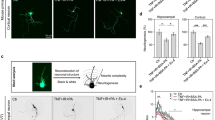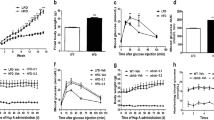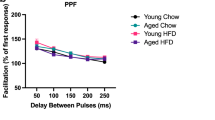Abstract
Objective:
Consumption of high-fat diet exerts adverse effects on learning and memory formation, which is linked to impaired hippocampal function. Activation of glucagon-like peptide-1 (GLP-1) signalling ameliorates detrimental effects of obesity-diabetes on cognitive function; however, mechanisms underlying these beneficial actions remain unclear. This study examined effects of daily subcutaneous treatment with GLP-1 mimetic, Liraglutide, on synaptic plasticity, hippocampal gene expression and metabolic control in adult obese diabetic (ob/ob) mice.
Results:
Long-term potentiation (LTP) induced by area CA1 was completely abolished in ob/ob mice compared with lean controls. Deleterious effects on LTP were rescued (P<0.001) with Liraglutide. Indeed, Liraglutide-treated mice exhibited superior LTP profile compared with lean controls (P<0.01). Expression of hippocampal brain-derived neurotropic factor and neurotrophic tyrosine kinase receptor-type 2 were not significantly different, but synaptophysin and Mash1 were decreased in ob/ob mice. Treatment with Liraglutide over 21 days increased expression of Mash1 in ob/ob mice (2.0-fold; P<0.01). These changes were associated with significantly reduced plasma glucose (21% reduction; P<0.05) and markedly improved plasma insulin concentrations (2.1- to 3.3-fold; P<0.05 to P<0.01). Liraglutide also significantly reduced the glycaemic excursion following an intraperitonal glucose load (area under curve (AUC) values: 22%; P<0.05) and markedly enhanced the insulin response to glucose (AUC values: 1.6-fold; P<0.05). O2 consumption, CO2 production, respiratory exchange ratio and energy expenditure were not altered by Liraglutide therapy. On day 21, accumulated food intake (32% reduction; P<0.05) and number of feeding bouts (32% reduction; P<0.05) were significantly reduced but simple energy restriction was not responsible for the beneficial actions of Liraglutide.
Conclusion:
Liraglutide elicits beneficial effects on metabolic control and synaptic plasticity in mice with severe obesity and insulin resistance mediated in part through increased expression of Mash1 believed to improve hippocampal neurogenesis and cell survival.
This is a preview of subscription content, access via your institution
Access options
Subscribe to this journal
Receive 12 print issues and online access
$259.00 per year
only $21.58 per issue
Buy this article
- Purchase on Springer Link
- Instant access to full article PDF
Prices may be subject to local taxes which are calculated during checkout





Similar content being viewed by others
References
Kandel ER, Spencer WA . Electrophysiological properties of an archicortical neuron. Ann NY Acad Sci 1961; 94: 570–603.
Sharma S, Rakoczy S, Brown-Borg H . Assessment of spatial memory in mice. Life Sci 2010; 87: 521–536.
de Bruin JP, Moita MP, de Brabander HM, Joosten RN . Place and response learning of rats in a Morris water maze: differential effects of fimbria fornix and medial prefrontal cortex lesions. Neurobiol Learn Mem 2001; 75: 164–178.
Pouzet B, Zhang WN, Feldon J, Rawlins JN . Hippocampal lesioned rats are able to learn a spatial position using non-spatial strategies. Behav Brain Res 2002; 133: 279–291.
Greenwood CE, Winocur G . Cognitive impairments in rats fed high-fat diets: a special effect of saturated fatty-acid intake. Behav Neurosci 1996; 110: 451–459.
Lindqvist A, Mohapel P, Bouter B, Frielingsdorf H, Pizzo D, Brundin P et al. High-fat diet impairs hippocampal neurogenesis in male rats. Eur J Neurol 2006; 13: 1385–1388.
Pistell PJ, Morrison CD, Gupta S, Knight AG, Keller JN, Ingram DK et al. Cognitive impairment following high fat diet consumption is associated with brain inflammation. J Neuroimmunol 2010; 219: 25–32.
Valladolid-Acebes I, Stucchi P, Cano V, Fernández-Alfonso MS, Merino B, Gil-Ortega M et al. High-fat diets impair spatial learning in the radial-arm maze in mice. Neurobiol Learn Mem 2011; 95: 80–85.
Porter DW, Kerr BD, Flatt PR, Hölscher C, Gault VA . Four weeks administration of Liraglutide improves memory and learning as well as glycaemic control in mice with high fat dietary-induced obesity and insulin resistance. Diabetes Obes Metab 2010; 12: 891–899.
Gault VA, Porter WD, Flatt PR, Hölscher C . Actions of exendin-4 therapy on cognitive function and hippocampal synaptic plasticity in mice fed a high-fat diet. Int J Obes 2010; 34: 1341–1344.
Gault VA, Hölscher C . GLP-1 agonists facilitate hippocampal LTP and reverse the impairment of LTP induced by beta-amyloid. Eur J Pharmacol 2008; 587: 112–117.
McClean PL, Gault VA, Harriott P, Hölscher C . Glucagon-like peptide-1 analogues enhance synaptic plasticity in the brain: a link between diabetes and Alzheimer’s disease. Eur J Pharmacol 2010; 630: 158–162.
Calhoun ME, Jucker M, Martin LJ, Thinakaran G, Price DL, Mouton PR . Comparative evaluation of synaptophysin-based methods for quantification of synapses. J Neurocytol 1996; 25: 821–828.
Carvalho AL, Caldeira MV, Santos SD, Duarte CB . Role of the brain-derived neurotrophic factor at glutamatergic synapses. Br J Pharmacol 2008; 153: 310–324.
Cohen-Cory S, Fraser SE . Effects of brain-derived neurotrophic factor on optic axon branching and remodelling in vivo. Nature 1995; 378: 192–196.
Ying SW, Futter M, Rosenblum K, Webber MJ, Hunt SP, Bliss TV et al. Brain-derived neurotrophic factor induces long-term potentiation in intact adult hippocampus: requirement for ERK activation coupled to CREB and upregulation of Arc synthesis. J Neurosci 2002; 22: 1532–1540.
Molteni R, Barnard J, Ying Z, Roberts CK, Gómez-Pinilla F . A high-fat, refined sugar diet reduces hippocampal brain-derived neurotrophic factor, neuronal plasticity and learning. Neuroscience 2002; 112: 803–814.
Blurton-Jones M, Kitazawa M, Martinez-Coria H, Castello NA, Muller FJ, Loring JF et al. Neural stem cells improve cognition via BDNF in a transgenic model of Alzheimer disease. Proc Natl Acad Sci USA 2009; 106: 13594–13599.
Haapasalo A, Sipola I, Larsson K, Akerman KE, Stoilov P, Stamm S et al. Regulation of TRKB surface expression by brain-derived neurotrophic factor and truncated TRKB Isoforms. J Biol Chem 2002; 277: 43160–43167.
Valtorta F, Pennuto M, Bonanomi D, Benfenati F . Synaptophysin: leading actor or walk-on role in synaptic vesicle exocytosis? Bioessays 2004; 26: 445–453.
Schmitt U, Tanimoto N, Seeliger M, Schaeffel F, Leube RE . Detection of behavioral alterations and learning deficits in mice lacking synaptophysin. Neuroscience 2009; 162: 234–243.
Casarosa S, Fode C, Guillemot F . Mash1 regulates neurogenesis in the ventral telencephalon. Development 1999; 126: 525–534.
Helms AW, Battiste J, Henke RM, Nakada Y, Simplicio N, Guillemot F et al. Sequential roles for Mash1 and Ngn2 in the generation of dorsal spinal cord interneurons. Development 2005; 132: 2709–2719.
Parras CM, Galli R, Britz O, Soares S, Galichet C, Battiste J et al. Mash1 specifies neurons and oligodendrocytes in the postnatal brain. EMBO J 2004; 23: 4495–4505.
Pleasure SJ, Collins AE, Lowenstein DH . Unique expression patterns of cell fate molecules delineate sequential stages of dentate gyrus development. J Neurosci 2000; 20: 6095–6105.
Doetsch F, Caille I, Lim DA, Garcia-Verdugo JM, Alvarez-Buylla A . Subventricular zone astrocytes are neural stem cells in the adult mammalian brain. Cell 1999; 97: 703–716.
Seri B, Garcia-Verdugo JM, McEwen BS, Alvarez-Buylla A . Astrocytes give rise to new neurons in the adult mammalian hippocampus. J Neurosci 2001; 21: 7153–7160.
Isacson R, Nielsen E, Dannaeus K, Bertilsson G, Patrone C, Zachrisson O et al. The glucagon-like peptide 1 receptor agonist exendin-4 improves reference memory performance and decreases immobility in the forced swim test. Eur J Pharmacol 2011; 650: 249–255.
Bailey CJ, Flatt PR, Atkins TW . Influence of genetic background and age on the expression of the obese hyperglycaemic syndrome in Aston ob/ob mice. Int J Obes 1982; 6: 11–21.
Stevens JF . Determination of glucose by an automated analyser. Clin Chem Acta 1971; 32: 199–201.
Flatt PR, Bailey CJ . Abnormal plasma glucose and insulin responses in heterozygous lean (ob/+) mice. Diabetologia 1981; 20: 573–577.
Stumvoll M, Goldstein BJ, van Haeften TW . Type 2 diabetes: principles of pathogenesis and therapy. Lancet 2005; 365: 1333–1346.
Kahn SE, Hull RL, Utzschneider KM . Mechanisms linking obesity to insulin resistance and type 2 diabetes. Nature 2006; 444: 840–846.
Farr SA, Yamada KA, Butterfield DA, Abdul HM, Xu L, Miller NE et al. Obesity and hypertriglyceridemia produce cognitive impairment. Endocrinology 2008; 149: 2628–2636.
Reijmer YD, van den Berg E, Ruis C, Kappelle LJ, Biessels GJ . Cognitive dysfunction in patients with type 2 diabetes. Diabetes Metab Res Rev 2010; 26: 507–519.
Yau PL, Javier DC, Ryan CM, Tsui WH, Ardekani BA, Ten S et al. Preliminary evidence for brain complications in obese adolescents with type 2 diabetes mellitus. Diabetologia 2010; 53: 2298–2306.
McNeilly AD, Williamson R, Sutherland C, Balfour DJ, Stewart CA . High fat feeding promotes simultaneous decline in insulin sensitivity and cognitive performance in a delayed matching and non-matching to position task. Behav Brain Res 2011; 217: 134–141.
Hamilton A, Patterson S, Porter D, Gault VA, Hölscher C . Novel GLP-1 mimetics developed to treat type 2 diabetes promote progenitor cell proliferation in the brain. J Neurosci Res 2011; 89: 481–489.
Friedman JM, Leibel RL, Siegel DS, Walsh J, Bahary N . Molecular mapping of the mouse ob mutation. Genomics 1991; 11: 1054–1062.
Maffei M, Fei H, Lee GH, Dani C, Leroy P, Zhang Y et al. Increased expression in adipocytes of ob RNA in mice with lesions of the hypothalamus and with mutations at the db locus. Proc Natl Acad Sci USA 1995; 92: 6957–6960.
Zhang Y, Proenca R, Maffei M, Barone M, Leopold L, Friedman JM . Positional cloning of the mouse obese gene and its human homologue. Nature 1994; 372: 425–432.
Coleman DL . Obese and Diabetes: two mutant genes causing diabetes-obesity syndromes in mice. Diabetologia 1978; 14: 141–148.
Gault VA, Irwin N, Green BD, McCluskey JT, Greer B, Bailey CJ et al. Chemical ablation of gastric inhibitory polypeptide receptor action by daily (Pro3)GIP administration improves glucose tolerance and ameliorates insulin resistance and abnormalities of islet structure in obesity-diabetes. Diabetes 2005; 54: 2436–2446.
Gault VA, Kerr BD, Harriott P, Flatt PR . Administration of an acylated GLP-1 and GIP preparation provides added beneficial glucose-lowering and insulinotropic actions over single incretins in mice with type 2 diabetes and obesity. Clin Sci 2011; 121: 107–117.
Rolin B, Larsen MO, Gotfredsen CF, Deacon CF, Carr RD, Wilken M et al. The long-acting GLP-1 derivative NN2211 ameliorates glycemia and increases beta-cell mass in diabetic mice. Am J Physiol Endocrinol Metab 2002; 283: 745–752.
Irwin N, McClean PL, Cassidy RS, O’Harte FP, Green BD, Gault VA et al. Comparison of the antidiabetic effects of GIP- and GLP-1-receptor activation in obese diabetic (ob/ob) mice: studies with DPP-IV resistant N-AcGIP and exendin(1-39)amide. Diabetes Metab Res Rev 2007; 23: 572–579.
Baggio LL, Drucker DJ . Biology of incretins: GLP-1 and GIP. Gastroenterology 2007; 132: 2131–2157.
Abbas T, Faivre E, Hölscher C . Impairment of synaptic plasticity and memory formation in GLP-1 receptor KO mice: interaction between type 2 diabetes and Alzheimer’s disease. Behav Brain Res 2009; 205: 265–271.
McLean PL, Parthsarathy V, Faivre E, Hölscher C . The diabetes drug Liraglutide prevents degenerative processes in a mouse model of Alzheimer’s disease. J Neurosci 2011; 31: 6587–6594.
Ying SW, Futter M, Rosenblum K, Webber MJ, Hunt SP, Bliss TV et al. Brain-derived neurotrophic factor induces long-term potentiation in intact adult hippocampus: requirement for ERK activation coupled to CREB and upregulation of Arc synthesis. J Neurosci 2002; 22: 1532–1540.
Bekinschtein P, Cammarota M, Katche C, Slipczuk L, Rossato JI, Goldin A et al. BDNF is essential to promote persistence of long-term memory storage. Proc Natl Acad Sci USA 2008; 105: 2711–2716.
Fernyhough P, Diemel LT, Brewster WJ, Tomlinson DR . Altered neurotrophin mRNA levels in peripheral nerve and skeletal muscle of experimentally diabetic rats. J Neurochem 1995; 64: 1231–1237.
Nitta A, Murai R, Suzuki N, Ito H, Nomoto H, Katoh G et al. Diabetic neuropathies in brain are induced by deficiency of BDNF. Neurotoxicol Teratol 2002; 24: 695–701.
Smith TD, Adams MM, Gallagher M, Morrison JH, Rapp PR . Circuit-specific alterations in hippocampal synaptophysin immunoreactivity predict spatial learning impairment in aged rats. J Neurosci 2000; 20: 6587–6593.
King DL, Arendash GW . Maintained synaptophysin immunoreactivity in Tg2576 transgenic mice during aging: correlations with cognitive impairment. Brain Res 2002; 926: 58–68.
Harvey J, Solovyova N, Irving A . Leptin and its role in hippocampal synaptic plasticity. Prog Lipid Res 2006; 45: 369–378.
McMahon HT, Bolshakov VY, Janz R, Hammer RE, Siegelbaum SA, Südhof TC . Synaptophysin a major synaptic vesicle protein, is not essential for neurotransmitter release. Proc Natl Acad Sci USA 1996; 93: 4760–4764.
Li H, Lee CH, Yoo KY, Choi JH, Park OK, Yan BC et al. Chronic treatment of exendin-4 affects cell proliferation and neuroblast differentiation in the adult mouse hippocampal dentate gyrus. Neurosci Lett 2010; 19: 1205–1219.
Acknowledgements
These studies were supported by an EFSD/GSK grant and University of Ulster Strategic Research Funding.
Author information
Authors and Affiliations
Corresponding author
Ethics declarations
Competing interests
The authors declare no conflict of interest.
Rights and permissions
About this article
Cite this article
Porter, W., Flatt, P., Hölscher, C. et al. Liraglutide improves hippocampal synaptic plasticity associated with increased expression of Mash1 in ob/ob mice. Int J Obes 37, 678–684 (2013). https://doi.org/10.1038/ijo.2012.91
Received:
Revised:
Accepted:
Published:
Issue Date:
DOI: https://doi.org/10.1038/ijo.2012.91
Keywords
This article is cited by
-
The relevance between abnormally elevated serum ceramide and cognitive impairment in Alzheimer’s disease model mice and its mechanism
Psychopharmacology (2024)
-
Targeting Insulin Resistance to Treat Cognitive Dysfunction
Molecular Neurobiology (2021)
-
Structural and functional consequences in the amygdala of leptin-deficient mice
Cell and Tissue Research (2020)
-
The Molecular Mechanism of Glucagon-Like Peptide-1 Therapy in Alzheimer’s Disease, Based on a Mechanistic Target of Rapamycin Pathway
CNS Drugs (2017)
-
Hippocampal insulin resistance and cognitive dysfunction
Nature Reviews Neuroscience (2015)



